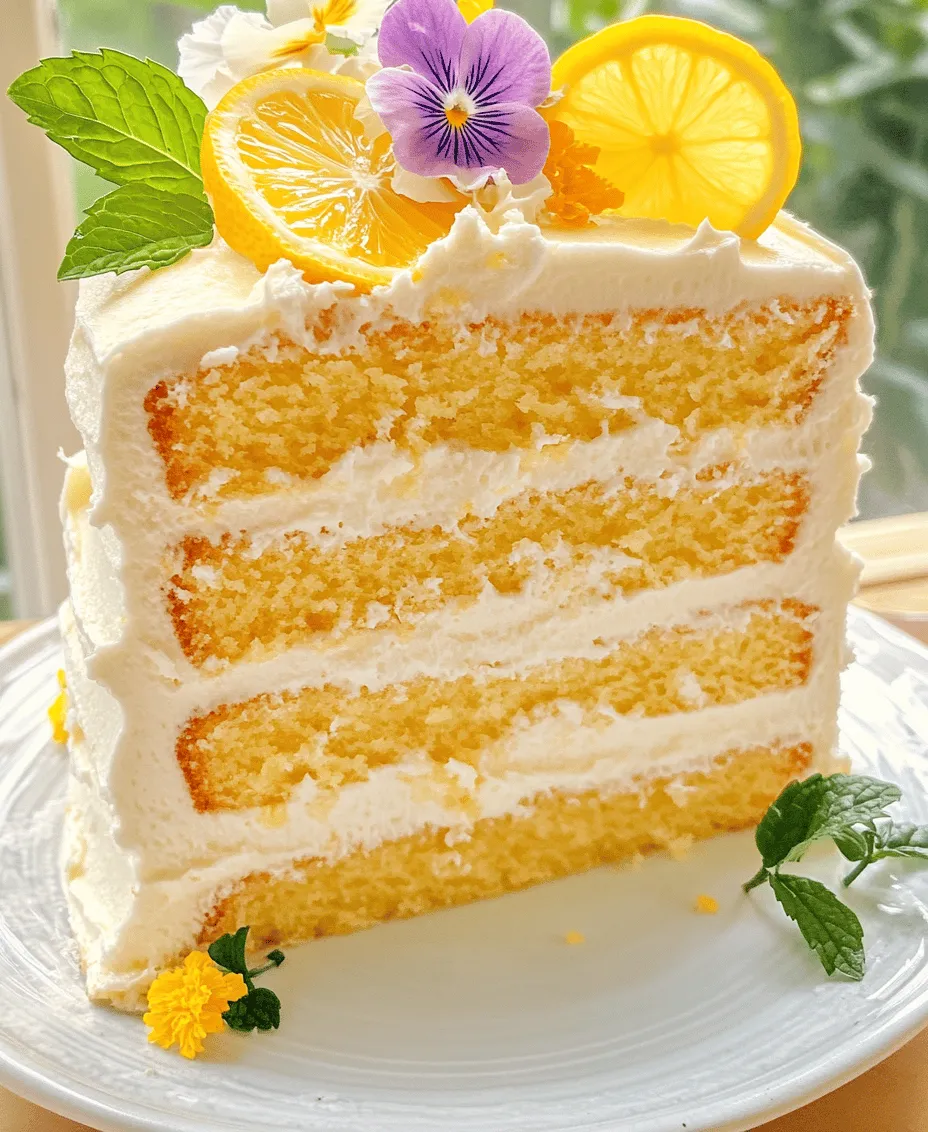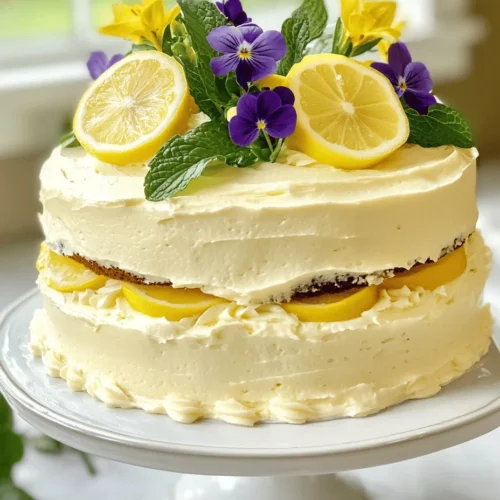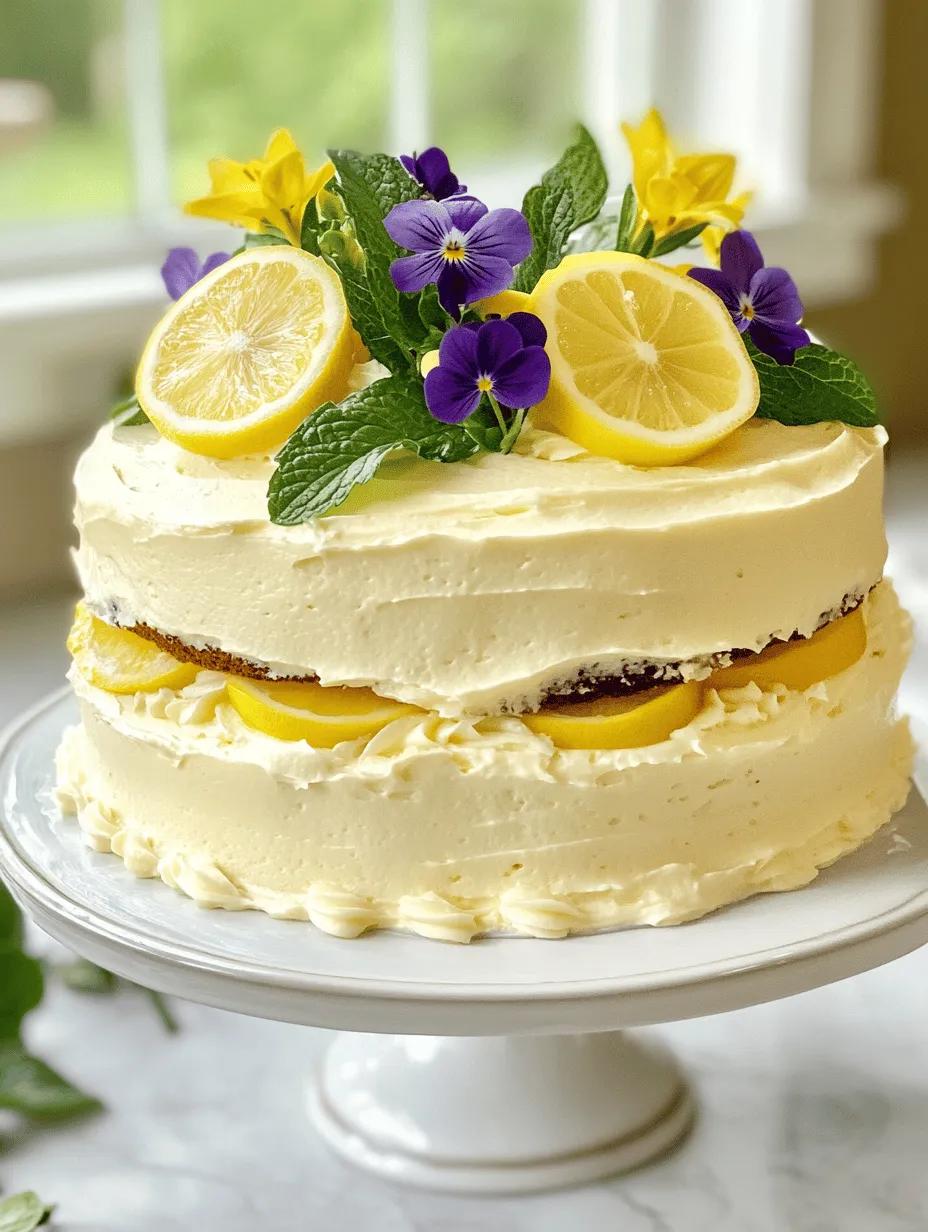Introduction
If you’re on the lookout for a dessert that embodies brightness and flavor, look no further than the Lemon Velvet Layer Cake. This delightful creation is a perfect choice for any occasion, whether you’re celebrating a birthday, hosting a summer gathering, or simply indulging in a sweet treat at home. The cake features a light and fluffy texture that melts in your mouth, complemented by a refreshing lemon flavor that enlivens your taste buds.
Lemon has long been a beloved ingredient in baking, known for its ability to elevate both sweet and savory dishes. Its zesty profile adds a unique twist that can transform a simple dessert into something extraordinary. The Lemon Velvet Layer Cake stands out not only for its vibrant taste but also for its visual appeal. Layered with rich cream cheese frosting and adorned with garnishes, this cake is a showstopper that will impress your guests and leave them reaching for seconds.
What makes this cake particularly versatile is its adaptability to various occasions. Whether you’re hosting a garden party, celebrating a milestone, or simply enjoying an afternoon tea with friends, this cake fits right in. Its bright lemon flavor pairs wonderfully with summer vibes, but it’s also comforting enough to enjoy year-round. Now, let’s explore what goes into making this delectable dessert and how you can create it at home.
Exploring the Ingredients
Lemon Cake Components
Creating the perfect Lemon Velvet Layer Cake starts with the right ingredients. Each component plays a crucial role in achieving the desired flavor and texture. Here’s a breakdown of what you’ll need:
– All-Purpose Flour: This is the backbone of your cake, providing structure and stability. The right balance of gluten in all-purpose flour ensures that your cake rises beautifully while maintaining a tender crumb.
– Baking Powder and Baking Soda: Both of these leavening agents are essential for achieving a light, airy texture. While baking powder reacts with the moisture and acidity in the batter, baking soda helps neutralize the acidity from the lemon juice, resulting in a well-risen cake.
– Salt: A small amount of salt is crucial for enhancing the flavors of your cake. It helps balance the sweetness and brings out the freshness of the lemon.
– Butter: Unsalted butter is a key ingredient that adds moisture and richness to the cake. It helps create that velvety texture that the cake is named after. Make sure your butter is at room temperature for easy creaming.
– Sugar: Granulated sugar not only sweetens the cake but also contributes to its moisture. The sugar is creamed with the butter to incorporate air into the batter, leading to a lighter cake.
– Eggs: Eggs provide structure and stability, binding the ingredients together while also adding moisture. They also help with the cake’s rise.
– Buttermilk: This ingredient adds acidity to the batter, which works in tandem with the baking soda to create a tender crumb. Buttermilk also enhances the flavor and moisture of the cake.
– Lemon Juice and Zest: The star of the show! Freshly squeezed lemon juice and zest provide that vibrant citrus flavor that makes this cake truly shine. The zest, in particular, adds an aromatic quality that elevates the entire dessert.
Understanding the role of each ingredient is key to achieving the perfect balance of flavors and textures in your Lemon Velvet Layer Cake.
Cream Cheese Frosting
No layer cake is complete without a luscious frosting, and for this recipe, we turn to cream cheese frosting. The combination of cream cheese, powdered sugar, and lemon juice creates a frosting that is both rich and tangy.
– Cream Cheese: The star ingredient in the frosting, cream cheese lends a creamy texture and a slight tang that complements the sweetness of the cake perfectly. It’s essential to use full-fat cream cheese for the best results.
– Powdered Sugar: This ingredient provides sweetness and helps achieve a smooth consistency. The fine texture of powdered sugar ensures that there are no gritty bits in your frosting.
– Lemon Juice: Just like in the cake, a splash of lemon juice in the frosting adds that signature zing. It cuts through the sweetness and enhances the overall flavor profile.
The combination of these ingredients results in a frosting that is not only delicious but also easy to spread between the cake layers and on the outside of the cake.
Garnishing Elements
To elevate your Lemon Velvet Layer Cake further, consider some garnishing elements that enhance both its aesthetic appeal and flavor.
– Lemon Slices: Thinly sliced lemons can be used as a beautiful topper for your cake. They add a pop of color and reinforce the lemon theme. For a more sophisticated touch, you can candy the lemon slices for added sweetness and texture.
– Edible Flowers: These can bring a delightful and whimsical touch to your cake. They not only make the presentation stunning but also can add subtle flavors, depending on the type of flowers used.
– Mint Leaves: Fresh mint leaves can add a refreshing contrast to the cake’s sweetness. Placing a few sprigs on top of the cake not only enhances the visual appeal but also adds a fresh aroma that complements the lemon.
Now that we’ve explored the ingredients needed for this delightful dessert, it’s time to dive into the step-by-step instructions to create the Lemon Velvet Layer Cake.
Step-by-Step Instructions
Prepping for Success
Before you start mixing ingredients, it’s crucial to prepare your kitchen for success. Begin by preheating your oven to 350°F (175°C). This ensures that the cake bakes evenly and achieves the desired rise. While the oven is heating, prepare your cake pans. Grease and flour two 9-inch round cake pans to prevent sticking. Alternatively, you can use parchment paper on the bottom of the pans for added security.
Having everything organized and ready to go will streamline the baking process and help you stay focused on creating a delicious final product.
Creating the Cake Batter
Now that your oven is preheated and your pans are ready, it’s time to create the cake batter. Follow these steps for a smooth and successful mixing process:
1. Cream the Butter and Sugar: In a large mixing bowl, use an electric mixer to cream together the softened unsalted butter and granulated sugar. Beat on medium speed until the mixture is light and fluffy, about 3-5 minutes. This step is crucial as it incorporates air into the batter, resulting in a light and airy cake.
2. Add the Eggs: One at a time, add the eggs to the butter and sugar mixture, beating well after each addition. This helps to ensure that the eggs are fully incorporated, which contributes to the structure of the cake.
3. Incorporate the Lemon: Add the lemon zest and lemon juice to the batter, mixing until fully combined. This is where the cake begins to take on its signature lemon flavor.
4. Combine the Dry Ingredients: In a separate bowl, whisk together the all-purpose flour, baking powder, baking soda, and salt. This helps to evenly distribute the leavening agents throughout the flour.
5. Alternate Adding Dry and Wet Ingredients: Gradually add the dry ingredient mixture to the butter mixture, alternating with the buttermilk. Start and end with the flour mixture, mixing just until combined after each addition. Be careful not to overmix, as this can lead to a dense cake.
6. Check the Consistency: The batter should be smooth and slightly thick. If it appears too thick, you can add a splash of buttermilk to reach your desired consistency.
With the batter complete, you’re ready to move on to the next steps of pouring it into the prepared cake pans and baking it to perfection.
This Lemon Velvet Layer Cake is not only a feast for the eyes but also a delightful experience for the palate. By following these detailed instructions and understanding the importance of each ingredient, you’re well on your way to creating a memorable dessert that will leave a lasting impression.

Creaming Method and Its Impact on Cake Lightness
The creaming method is a foundational technique in cake baking, crucial for achieving the light and airy texture characteristic of the Lemon Velvet Layer Cake. This process begins by beating softened butter and sugar together until the mixture becomes pale and fluffy. The incorporation of air during this stage is essential, as it helps to leaven the cake by creating tiny air pockets. This lightness is what allows the cake to rise beautifully during baking, resulting in a tender crumb that melts in your mouth.
To properly execute the creaming method, ensure that your butter is at room temperature, which allows for better aeration. Use a stand mixer fitted with a paddle attachment or a hand mixer to beat the butter and sugar together for about 3-5 minutes. The mixture should look light and have increased in volume. Once the desired consistency is achieved, you can then add the eggs one at a time, ensuring each egg is fully incorporated before adding the next. This gradual addition further enhances the emulsion, contributing to the cake’s moist texture.
Alternating Dry and Wet Ingredients for a Smooth Batter
Once your butter and sugar mixture is ready, the next step involves incorporating the dry and wet ingredients. This process not only adds flavor but also forms the structure of the cake. Begin by sifting together the dry ingredients—flour, baking powder, and salt—in a separate bowl. The sifting process eliminates any lumps and ensures an even distribution of the leavening agent.
When combining the dry and wet ingredients, it’s essential to alternate between them. Start by adding one-third of the dry mixture to the creamed butter and sugar, followed by half of the buttermilk (or any other liquid you’re using). Continue this pattern—dry, wet, dry—until all ingredients are combined. Mixing in this manner prevents overmixing, which can lead to a dense cake. The goal is to mix until the ingredients are just combined, resulting in a smooth batter with no visible flour streaks.
Baking and Cooling
With your batter prepared, it’s time to bake! Preheat your oven to 350°F (175°C) and prepare your cake pans by greasing them and lining the bottoms with parchment paper. This step is crucial for preventing the cake from sticking.
When you pour the batter into the prepared pans, be sure to distribute it evenly. For even baking, use a kitchen scale to measure the batter for each pan, ensuring that each layer is the same size. This not only promotes uniform baking but also helps with the overall presentation of the cake.
Bake the layers for about 25-30 minutes, or until a toothpick inserted into the center comes out clean. Keep an eye on the cakes, as oven temperatures can vary. Once baked, remove the cakes from the oven and allow them to cool in the pans for 10 minutes before transferring them to wire racks. Cooling is vital, as it allows the layers to set and firm up, which makes them easier to handle when layering.
Tips for Even Baking and Cooling Time
To achieve even baking, avoid opening the oven door frequently, as this can cause fluctuations in temperature. Additionally, rotating the pans halfway through the baking process ensures that all sides of the cakes receive equal heat exposure. After cooling for the initial 10 minutes, invert the cakes onto the wire racks to cool completely. This step is crucial, as layering warm cakes can lead to a soggy texture.
Making the Frosting
The frosting is where the Lemon Velvet Layer Cake truly shines, adding a rich and tangy layer of flavor. For a classic cream cheese frosting, combine softened cream cheese and butter in a mixing bowl and beat until smooth and creamy. Gradually add powdered sugar, adjusting the amount based on your desired sweetness. A pinch of salt enhances the flavor and balances the sweetness of the frosting.
To incorporate the lemon flavor, add freshly grated lemon zest along with a splash of lemon juice. This not only enhances the frosting’s flavor profile but also ties it beautifully with the cake. The consistency should be thick enough to hold its shape yet spreadable. If the frosting is too thick, you can add a bit more lemon juice or milk until the desired consistency is achieved.
Assembling the Lemon Velvet Layer Cake
Now that you have your layers baked and cooled, along with a luscious frosting ready, it’s time to assemble the Lemon Velvet Layer Cake.
Layering Technique
Start by placing the first layer of cake on a cake stand or serving plate. Use a serrated knife to level the top if needed, ensuring a stable base for the frosting. Spread a generous layer of frosting on top, ensuring even coverage up to the edges. Place the second layer on top and repeat the process until all layers are stacked.
When frosting between layers, use a spatula to create an even thickness, which provides stability and balance to the cake. Pay attention to the edges, as the frosting should slightly overflow to create a smooth finish once the top layer is added.
Tips on Frosting the Sides and Top for a Polished Look
After stacking your layers, it’s time to frost the sides and top of the cake. Apply a thin layer of frosting around the sides first—this is known as a crumb coat, which locks in any loose crumbs. Chill the cake for about 30 minutes to set the crumb coat before applying the final layer of frosting.
Once chilled, use an offset spatula to apply a thicker layer of frosting around the sides and on top of the cake. For a smooth finish, run a bench scraper around the sides, holding it vertically. This technique helps achieve a professional-looking finish, making your Lemon Velvet Layer Cake truly impressive.
Garnishing for Presentation
The visual appeal of your cake can enhance the overall experience, making it not just a dessert but a centerpiece.
Artful Decoration
Consider garnishing your cake with lemon slices arranged artfully on top, adding a pop of color and a hint of freshness. Edible flowers, such as pansies or nasturtiums, can also be added for a vibrant touch. Fresh mint leaves scattered around the cake not only add color but also a refreshing aroma that complements the lemon flavor beautifully.
Serving Suggestions
Pair your Lemon Velvet Layer Cake with a variety of beverages for an elevated dessert experience. A cup of Earl Grey tea or a refreshing glass of iced lemon tea enhances the citrus notes of the cake. Alternatively, serve it alongside a scoop of vanilla ice cream or a dollop of whipped cream for added indulgence. For a more festive touch, consider serving it with a citrus-infused sparkling water or a light prosecco.
Conclusion
The Lemon Velvet Layer Cake is a delightful addition to any dessert table, offering a refreshing flavor that is sure to impress your guests. Its beautiful presentation, complete with artful garnishes, makes it a showstopper for any occasion, from birthdays to casual family gatherings.
As you dive into the process of baking and assembling this cake, take time to enjoy each step—from creaming the butter to frosting the layers. The joy of sharing this delicious creation with loved ones is what makes baking truly special. So gather your ingredients, preheat that oven, and get ready to create a cake that not only tastes amazing but also brings a touch of sunshine to your table. Enjoy every moment of this delightful baking adventure!


